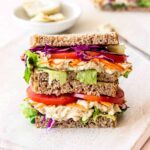Dive into a world of vibrant colors and tantalizing flavors with plant-based charcuterie boards! Forget the limitations of traditional meat and cheese; this exciting culinary trend offers endless possibilities for creativity and deliciousness. From smoky plant-based “meats” to creamy vegan cheeses and an array of colorful accompaniments, building a stunning and flavorful plant-based charcuterie board is easier than you might think. This guide will equip you with the knowledge and inspiration to craft boards that are not only visually appealing but also bursting with diverse textures and taste sensations, catering to various dietary needs and preferences.
We’ll explore trending plant-based components, innovative layout ideas, and delicious flavor combinations, providing step-by-step instructions to guide you through the process. Learn how to balance sweet, savory, salty, and acidic elements for a harmonious culinary experience. Discover how to create height and visual interest using different serving dishes and risers, transforming your board into a true centerpiece. We’ll even address common dietary restrictions, offering adaptable recipes to accommodate various needs. Get ready to impress your guests with a plant-based charcuterie board that’s as delicious as it is beautiful!
Flavor Combinations for Plant-Based Charcuterie Boards
Crafting a plant-based charcuterie board is an art of balancing textures and tastes, creating a symphony of flavors that delight the palate. The key lies in exploring diverse flavor profiles and thoughtfully selecting ingredients that complement each other. A successful board goes beyond simply arranging items; it’s about creating a culinary experience.
Mediterranean Mezze Board
This vibrant board evokes the sun-drenched landscapes of the Mediterranean. Imagine a spread of rich colors and aromatic herbs, offering a taste of the region’s culinary heritage. The ingredients are chosen to provide a balance of textures and tastes, creating a harmonious and satisfying experience.
- Spreads: Creamy hummus, vibrant baba ghanoush (smoky eggplant dip), and a sun-dried tomato pesto.
- Vegetables: Marinated artichoke hearts, Castelvetrano olives bursting with briney flavor, sweet cherry tomatoes, and crisp cucumber slices.
- Fruits: Figs, juicy grapes, and pomegranate arils, offering a touch of sweetness and contrasting textures.
- Other: Warm pita bread, toasted baguette slices, and marinated Kalamata olives.
Spicy Asian-Inspired Board
This board offers a thrilling adventure for the taste buds, a journey through the vibrant and spicy landscapes of Asia. The combination of sweet, savory, spicy, and umami flavors creates a dynamic and unforgettable experience.
- Spreads: Spicy kimchi, a creamy peanut satay sauce, and a sweet chili garlic sauce.
- Vegetables: Pickled ginger, vibrant red bell peppers, shredded carrots, and crisp bean sprouts.
- Fruits: Mandarin orange segments, lychees, and fresh mango chunks offering a juicy counterpoint to the savory elements.
- Other: Crispy rice crackers, seaweed crisps, and edamame pods.
Southwestern Fiesta Board
This board bursts with the vibrant colors and bold flavors of the American Southwest. It’s a celebration of fresh ingredients and zesty spices, creating a lively and flavorful experience.
- Spreads: Black bean dip, roasted red pepper hummus, and a smoky chipotle cashew cream cheese.
- Vegetables: Marinated jalapeños, roasted corn, colorful bell peppers, and crisp tortilla chips.
- Fruits: Sliced avocado, juicy mango, and pomegranate seeds offering a refreshing counterpoint.
- Other: Tortilla chips, plantain chips, and various types of salsa.
Recipe: Roasted Red Pepper and Walnut Pâté
This vibrant pâté is both flavorful and easy to make, offering a rich and satisfying spread for your plant-based charcuterie board. Its creamy texture and deep flavor will impress your guests.
- Ingredients: 1 large red bell pepper, 1/2 cup walnuts, 2 tablespoons nutritional yeast, 1 tablespoon olive oil, 2 cloves garlic, 1 tablespoon lemon juice, salt and pepper to taste.
- Instructions:
- Roast the red pepper: Preheat oven to 400°F (200°C). Halve the pepper, remove seeds, and place cut-side down on a baking sheet. Roast for 20-25 minutes, or until the skin is blackened and blistered.
- Prepare the walnuts: While the pepper roasts, toast the walnuts in a dry skillet over medium heat for 5-7 minutes, or until fragrant.
- Combine ingredients: Once the pepper has cooled slightly, peel off the skin. Combine the roasted pepper, toasted walnuts, nutritional yeast, olive oil, garlic, and lemon juice in a food processor. Process until smooth and creamy.
- Season and serve: Season with salt and pepper to taste. Transfer to a serving bowl and chill for at least 30 minutes before serving.
Balancing Flavors on a Plant-Based Charcuterie Board
Achieving a harmonious balance of sweet, savory, salty, and acidic elements is crucial for a truly exceptional plant-based charcuterie board. The interplay of these flavors creates depth and complexity, preventing the board from becoming monotonous. For example, the sweetness of fruit can cut through the richness of a creamy dip, while the saltiness of olives complements the savory notes of roasted vegetables. The acidity of pickled vegetables adds a refreshing zing, enhancing the overall experience. A well-balanced board is a testament to careful planning and consideration of each ingredient’s contribution to the overall flavor profile.
Step-by-Step Guide to Creating a Plant-Based Charcuterie Board

Crafting a stunning plant-based charcuterie board is easier than you might think. With a little planning and attention to detail, you can create a visually appealing and delicious spread that will impress your guests. This guide provides a simple, step-by-step approach to building a board that’s both beautiful and bursting with flavor.
Selecting and Preparing Ingredients
Choosing a diverse range of ingredients is key to creating a captivating plant-based charcuterie board. Consider textures, colors, and flavors to ensure a balanced and exciting experience. Think vibrant reds from roasted red peppers, deep greens from olives and artichoke hearts, creamy whites from cashew cheese, and earthy browns from crackers and nuts.
- Fruits: Select a variety of colors and textures. Imagine juicy grapes in deep purples and greens, alongside bright orange slices of mandarin or segments of blood orange. Consider adding dried fruits like apricots or figs for a chewy contrast.
- Vegetables: Offer a mix of crunchy and soft vegetables. Think crisp cucumber slices, vibrant bell pepper strips, marinated artichoke hearts, and juicy cherry tomatoes. Roasted red peppers add a smoky sweetness.
- Plant-Based Cheeses: Incorporate a selection of plant-based cheeses to offer diverse flavor profiles. A creamy cashew cheese, a sharp cheddar alternative, and a smoky aged gouda substitute will provide a satisfying range of tastes and textures.
- Crackers and Breads: Choose a variety of crackers and breads to offer textural contrast. Consider water crackers, multigrain crackers, seeded bread, and perhaps even some toasted baguette slices.
- Nuts and Seeds: Add a generous assortment of nuts and seeds for healthy fats and satisfying crunch. Think roasted almonds, cashews, pumpkin seeds, and sunflower seeds. Consider adding a sprinkle of everything bagel seasoning for extra flavor.
- Spreads and Dips: Include a selection of dips and spreads to complement the other ingredients. A vibrant hummus, a creamy avocado dip, or a spicy sun-dried tomato pesto will add layers of flavor and visual interest.
Arranging the Board for Visual Appeal
The arrangement of your ingredients is crucial to the overall aesthetic appeal of your board. Aim for a visually balanced and harmonious composition, playing with colors, shapes, and textures.
- Start with the Base: Begin by arranging larger items, such as bowls of dips or larger cheeses, to create a foundation for the rest of the ingredients.
- Create Visual Clusters: Group similar items together to create visual clusters. For instance, place all the cheeses together, all the fruits together, and so on. This helps to create a sense of order and balance.
- Vary Heights and Textures: Use different heights to add dimension to the board. You can achieve this by using small bowls, stacking crackers, or using items of varying sizes. Ensure a good balance of textures – crunchy, creamy, soft – to create a dynamic sensory experience.
- Fill in Gaps Strategically: Once you have placed the larger items, fill in any gaps with smaller items, such as nuts, seeds, or dried fruits. This ensures the board looks full and visually appealing.
- Consider Color Placement: Think about the color wheel. Arrange ingredients to create a pleasing color contrast and visual harmony. Avoid placing similar colors next to each other; instead, create a balanced distribution of colors across the board.
- Add Garnishes: Finish the board with some fresh herbs, edible flowers, or a sprinkle of spices to add a touch of elegance and visual interest. A few sprigs of rosemary or thyme can add a beautiful touch.
Preparing and Presenting the Board
Preparing your board in advance allows for optimal flavor development and efficient presentation.
- Prepare Ingredients Ahead: Wash and chop vegetables, prepare dips, and arrange cheeses in advance to save time when assembling the board.
- Chill Ingredients (if necessary): Some ingredients, like cheeses, benefit from chilling before serving. This helps maintain their texture and flavor.
- Assemble the Board Just Before Serving: This prevents ingredients from wilting or drying out. Arrange everything attractively on your chosen board or platter.
- Serve at Room Temperature (generally): Most plant-based charcuterie board ingredients are best served at room temperature for optimal flavor and enjoyment. Exceptions might include chilled dips or cheeses.
- Consider Serving Utensils: Provide small knives, spoons, and forks to make it easy for guests to serve themselves.
- Presentation Matters: A beautifully arranged board enhances the overall dining experience. Take your time and arrange the ingredients thoughtfully for maximum visual impact.
Dietary Considerations and Variations
Creating a plant-based charcuterie board that delights everyone requires careful consideration of diverse dietary needs. Many individuals follow specific diets due to allergies, intolerances, or personal preferences. Adapting your board to accommodate these needs not only shows consideration but also expands the possibilities for exciting flavor combinations.
This section explores common dietary restrictions and offers practical solutions for creating inclusive and delicious plant-based charcuterie boards. We’ll also delve into the nutritional aspects of various components and strategies for visual appeal.
Dietary Restriction Variations
Three prevalent dietary restrictions—gluten-free, soy-free, and nut-free—often require thoughtful adjustments when building a plant-based charcuterie board. The following variations provide delicious alternatives while maintaining the board’s visual appeal.
Gluten-Free: Many crackers and breads contain gluten. To create a gluten-free board, substitute gluten-free crackers, such as those made from rice, corn, or quinoa. Look for gluten-free pretzels or veggie sticks as well. Ensure that any dips or spreads used are also certified gluten-free. Many naturally gluten-free options exist, such as olives, fruits, and vegetables.
Soy-Free: Soy is a common ingredient in many plant-based products, including some cheeses and meats. To create a soy-free board, carefully check labels to ensure that all ingredients are soy-free. Consider using tofu-based products from brands that clearly state they are soy-free. Many other plant-based options, such as mushrooms, tempeh (if not made with soy), and various vegetables, offer rich textures and flavors.
Nut-Free: Nuts are a popular addition to plant-based charcuterie boards, but they are a common allergen. To make a nut-free board, replace nuts with seeds like sunflower seeds, pumpkin seeds, or hemp seeds. Consider using seed-based butters or dips instead of nut-based ones. Be mindful of cross-contamination, especially if preparing the board in a kitchen where nuts are regularly handled.
Nutritional Comparison of Plant-Based Charcuterie Board Components
Understanding the nutritional profiles of various components allows for a balanced and health-conscious plant-based charcuterie board. The table below offers a general comparison; specific nutritional values vary depending on brands and preparation methods.
| Component | Calories (approx. per serving) | Protein (approx. per serving) | Fiber (approx. per serving) |
|---|---|---|---|
| Cucumber slices | 8 | 0.5g | 0.5g |
| Hummus (2 tbsp) | 70 | 3g | 2g |
| Avocado slices (1/4 avocado) | 80 | 2g | 4g |
| Plant-based sausage (1 slice) | 50-70 | 4-6g | 1-2g |
| Whole-grain crackers (2 crackers) | 50-70 | 2-3g | 1-2g |
| Black olives (5-6 olives) | 30 | 0.5g | 1g |
Strategies for Visually Appealing and Delicious Plant-Based Charcuterie Boards
Creating a visually appealing and delicious plant-based charcuterie board involves strategic arrangement and selection of components. A variety of colors, textures, and flavors is key to a successful board. Consider the following strategies.
Color Variety: Incorporate a rainbow of colors. Deep reds from tomatoes and peppers contrast beautifully with the greens of olives and spinach dips, while vibrant yellows from corn or bell peppers add brightness. The earthy tones of mushrooms and olives add depth.
Texture Contrast: Offer a mix of textures to engage different senses. Crisp crackers and vegetables complement creamy dips and soft cheeses. The contrasting textures make the experience more interesting and enjoyable.
Flavor Combinations: Think about flavor pairings. Sweet and savory elements work well together, such as figs with balsamic glaze or dates with goat cheese (vegan alternative). Spicy elements, like marinated artichoke hearts, can add excitement.
Presentation: Arrange components thoughtfully, creating visual interest. Use different heights and levels to add dimension. Consider using small bowls for dips and spreads, and arrange items in a visually pleasing manner, perhaps with a spiral or radial pattern. Garnishing with fresh herbs adds a final touch of elegance.
Creating a plant-based charcuterie board is a journey of culinary exploration, allowing you to express your creativity and cater to diverse tastes. From the careful selection of vibrant ingredients to the artful arrangement on your board, each step contributes to a final masterpiece that’s both visually stunning and incredibly delicious. By understanding the principles of flavor balancing, texture contrast, and visual appeal, you can craft boards that are not only satisfying but also reflect your personal style and culinary flair. So gather your ingredients, unleash your inner artist, and prepare to delight your guests with a plant-based charcuterie board that’s unforgettable!
Detailed FAQs
What is the best way to store leftover plant-based charcuterie board items?
Store leftover items in airtight containers in the refrigerator. Many items will keep for several days. However, some items, like certain plant-based cheeses, may be best consumed within a day or two.
Can I make a plant-based charcuterie board ahead of time?
Yes, many components can be prepared in advance. Prepare the plant-based “meats,” cheeses, and spreads a day or two before. Assemble the board a few hours before serving for optimal freshness and flavor.
What are some good alternatives to nuts for those with allergies?
Sunflower seeds, pumpkin seeds, roasted chickpeas, or even dried fruits can be great nut-free alternatives to add texture and flavor to your board.
How can I make my plant-based charcuterie board more festive for a special occasion?
Use festive-colored serving platters, incorporate seasonal fruits and vegetables, add decorative elements like edible flowers, and arrange items in a more elaborate design.


